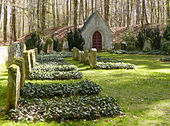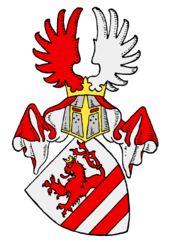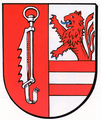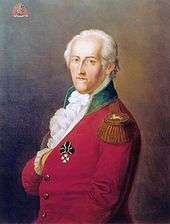Knigge (noble family)
Knigge is a Lower Saxon noble family that belongs to the Calenberg nobility . Most family members today have the historically established name "Freiherr (Freifrau) Knigge".
history
origin
The gender is said to originally come from the area around Bremen and appear in Mindic documents from the 13th century . In 1489, according to Luneburg Mushard , the last Bremen properties were sold and the entire family settled in the Duchy of Braunschweig-Lüneburg .
According to the Genealogical Handbook of the Nobility , the gender with the knight ( miles ) Ekbertus Knigge is first mentioned in a document dated June 26, 1241. He belonged to the castle crew of the castle Pattensen in the county Hallermund . The line begins with the "nobilis" Henricus de Knick (Cnigke) mentioned in 1233 and 1239 . The name is probably derived from the kink , a medieval wall hedge.
Spread and personalities

Hermann I. Knigge is mentioned from 1270 to 1305 as a knight with fief in Hemmingen . Ludolf Knigge is mentioned in a document in 1338 as a knight and owner of the Vogtei zu Pattensen, where the family is still based today on a former Burgmannshof and later manor . Knigge Knigge also became owners of Bredenbeck Castle in 1312 , which they expanded into a heavily fortified moated castle and inhabited from 1338. In 1370 the Duke belehnte Magnus II. The Knights Kniegen with another Wasserburg in Leveste . This was demolished in 1425 after an agreement between Duke Bernhard I and the City Council of Hanover , as the citizens of the city feared the nearby meeting place of war-ready knights. A moated castle was built in place of the castle, from 1728–1732 the baroque Levester mansion was originally a three-winged complex, which - like the goods in Pattensen and Bredenbeck - is owned by the Barons Knigge to this day. Due to the ownership of the estates in Bredenbeck (Burggut and Schlossgut), Leveste and Pattensen, the family belongs to the knightly nobility of the Calenberg landscape .
Otto and Hermann Knigge lived in 1353. Heinrich and Hans Knigge appear in a document in 1373 as witnesses. The oldest calenberg fiefdom of the family dates from 1390.
Later, around 1650, Jacob Knigge became a royal Swedish lieutenant general . Baron Friedrich Ulrich von Knigge (1618–1683) died as an imperial colonel and chamberlain for the Electorate of Cologne . His brother Jobst Hilmar Freiherr Knigge (1605–1683) became an imperial field marshal lieutenant and commandant of Glogau . Maximilian Friedrich Casimir Freiherr Knigge, the son of Friedrich Ulrich, was the Duke of Courland Oberhofmarschall . Later he became a property in the county of Mansfeld zu Friedrichsrode and was able to continue the baronial tribe. Of his four sons, the eldest princely Braunschweig-Wolfenbüttler became a privy councilor , the second a British and Kurdish-Brunswick district and treasury council, the third served as a constable sergeant and the youngest as a cavalry officer in royal Polish and electoral Saxon services.
Adolph Franz Friedrich Ludwig Freiherr Knigge (* 1752), one of the most important representatives of the family , came from the Hanover branch . He was the author of the well-known work On dealing with people that was first published in Hanover in 1788. From 1790 he was captain and first scholarch of the cathedral school in Bremen . He died there in 1796 and was buried in Bremen Cathedral. His grave slab can still be seen there today.
In 1678, the rule of Arnstein am Harz, in the former Mansfeld mountain district , was pledged to Baron Knigge due to the insolvency of the Counts of Mansfeld -vorort, with the exception of Arnstein Castle . In 1812 - in the Kingdom of Westphalia under Jérôme Bonaparte - the Knigges came into the final possession of the Arnstein rule. In addition to the castle, the property also included the manors in Pfersdorf (Arnstein) , Endorf and Harkerode. They had built a new castle in Harkerode around 1700 , which they owned until the expropriation in 1945, as well as the Arnstein castle ruins and the Endorf manor, the property in Pfersdorf was sold in the 1930s.
One line reached the Mark Brandenburg and was owned by Blankensee, Blankfeld, Goldbach and Schwiebus in 1681. Members of this line were also wealthy in Silesia in Kuttlau near Glogau and in 1721 in Courland in Bixten.
Status surveys
The Knigge belong to the ancient nobility of Lower Saxony , Henricus de Knick , mentioned in 1233 , had an from in the name, but in the Middle Ages it was more of a denomination of origin or possession than a denomination of nobility , which was largely no longer used in later generations by the Knigges. (Before the 17th century, belonging to the nobility was more likely to be documented by the use of coats of arms, designations such as miles (knight), lord, and by belonging to the corporated knighthood of a country, rather than nobility.)
On June 19, 1665 brothers Jobst Knigge Hilmar, imperial Colonel Field sergeant received, and Friedrich Knigge, imperial colonel and kurkölnischer Chamberlain to Vienna the baron status with the salutation Honor and a coat of arms improvement . Both received electoral Saxon recognition on September 20, 1670. Maximilian Freiherr Knigge auf Bixten and his brother Georg Freiherr Knigge auf Strasden were enrolled in the Courland knighthood on June 19, 1763. Also August Freiherr Knigge auf Zehren on March 4, 1863.
coat of arms
Family coat of arms
The family coat of arms is divided. Above in silver a growing two-tailed gold-crowned red lion , below divided three times by red and silver. On the helmet with red and silver helmet covers an open flight of red on the right and silver on the left .
Baron coat of arms
The coat of arms of the imperial barons, awarded in 1665, is quartered and covered with a crowned silver middle shield , inside a bar divided by red and gold and covered with three (2, 1) blue lilies , accompanied by three (2, 1) red hearts . 1 and 4 the family coat of arms with the lion growing inwards. 2 and 3 in gold between two black bars, two black diamonds next to each other. The coat of arms has three helmets with red and silver helmet covers on the right and black and gold on the left. On the right an open red flight on the right, a silver flight on the left, on the middle a seated forward-facing red lion, in each front paw holding three outward-flying red flags covered with a silver crescent on silver rods adorned with a silver crescent. On the left a crowned, three-fold black-striped golden column, standing obliquely to the left, decorated with a natural peacock's whisk, each with a black diamond. Two crowned red lions
as a shield holder .
Local and municipal coats of arms
Elements from the coat of arms of the Knigge family appear in some of Lower Saxony's local and community coats of arms.
Coat of arms of Beienrode , district of Königslutter
Well-known namesake
- Jobst Hilmar von Knigge (1605–1683), imperial field marshal lieutenant
- Friedrich Ulrich von Knigge (1618–1683), imperial colonel
- Georg Ernst von Knigge (1651–1705), German administrative officer and governor
- Maximilian Friedrich Casimir von Knigge (1653–1721), Courland Oberhofmarschall
- Adolph Freiherr Knigge (1752–1796), German writer and namesake of the "Knigge" .
- Philippine Freiin Knigge (1775–1841), daughter of Adolph Knigge, writer and aphorist
- August Freiherr Knigge (1854–1931), captain and member of parliament
- Wilhelm Freiherr Knigge (1863–1932), manor owner and member of the German Reichstag
- Wilhelm Carl Ernst Freiherr Knigge (1771–1839), Kgl. Hann. Castle captain u. District Administrator , brought the Bredenbeck and Pattensen estates back into the family's possession; Son of Georg Wilhelm (1731–1801) and Henriette Louise von Pfuel (1735–1798)
- Moritz Freiherr Knigge (* 1968), German management consultant
literature

- Ernst Heinrich Kneschke : New general German nobility lexicon . Volume 5, Friedrich Voigt's Buchhandlung, Leipzig 1864, pp. 159–160. ( Digitized version )
- Genealogisches Handbuch des Adels , Adelslexikon Volume VI, Volume 91 of the complete series, p. 317. CA Starke Verlag, Limburg (Lahn) 1987, ISSN 0435-2408
- Genealogical manual of the nobility , Freiherrliche Häuser Volume XX, Volume 118 of the complete series, p. 205. CA Starke Verlag, Limburg (Lahn) 1999, ISBN 3-7980-0820-5 .
- Gothaisches genealogical pocket book of the baronial houses to the year 1864 p.420ff . 1865 p.494ff , 1873 p.432ff
Web links
Individual evidence
- ↑ a b c d New General German Adels Lexicon Volume 4, pp. 159–160.
- ^ Brunswick coats of arms in Johann Siebmacher's coat of arms book (around 1605)
- ^ Document book of the city of Hanover , 1860, p. 10.
- ↑ a b c d Genealogisches Handbuch des Adels , Adelslexikon Volume VI, Volume 91 of the complete series, p. 317.
- ↑ a b c Genealogical Handbook of the Nobility, Freiherrliche Häuser Volume XX, Volume 118 of the complete series, 1999, p. 205.
- ↑ The story of Leveste on Leveste.de (accessed on July 15, 2015)
- ↑ Paul Raabe: "--in my country back": Adolph Freiherr Knigge in Hanover from 1787 to 1790 . Wallstein Verlag, 2002, ISBN 978-3-89244-639-2 , pp. 68–.






